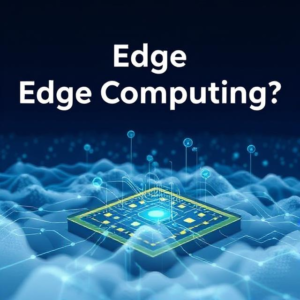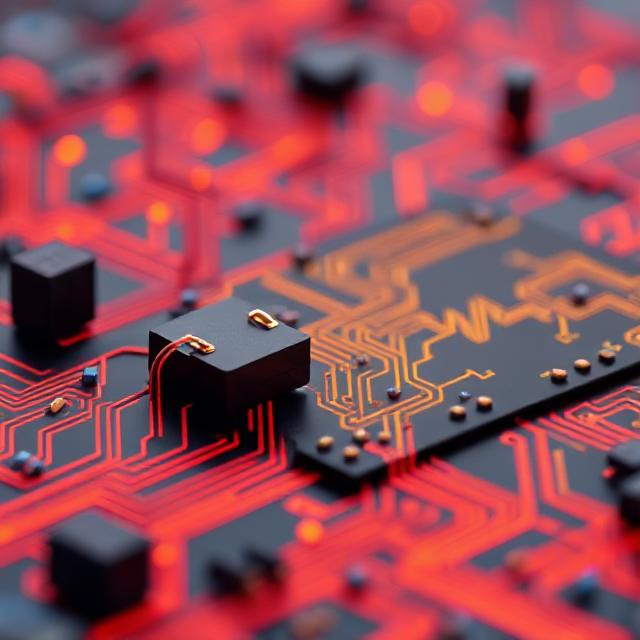What is Edge Computing?
Edge computing refers to processing data closer to where it is generated, rather than sending all the data to a centralized cloud or data center for processing. The “edge” typically means devices or systems that are physically closer to the data source—like sensors, smartphones, or smart devices—rather than in the cloud or far away servers.

Why is Edge Computing Important?
- Speed: By processing data locally, at the edge, we reduce the time it takes for data to travel to the cloud and back. This results in lower latency (faster responses).
- Efficiency: Instead of sending large amounts of raw data to the cloud, only relevant or processed information is sent, saving bandwidth and reducing costs.
- Reliability: In cases where there’s limited or no internet connectivity, edge computing allows devices to continue functioning independently by processing data on the device itself.
Examples of Edge Computing:
- Smartphones: Your phone processes data locally to run apps, recognize your face, or optimize battery usage.
- IoT Devices: A smart thermostat adjusts the temperature in your home by processing data directly on the device instead of sending data to the cloud every time it changes.
- Autonomous Vehicles: Self-driving cars process data from cameras, sensors, and radar right on the car to make real-time driving decisions without needing constant communication with a cloud server.
What are High-Speed Data Interfaces?
High-speed data interfaces are ways for different devices to communicate quickly by transmitting data at very fast rates. These interfaces are designed to handle large amounts of data with minimal delays, which is critical in modern applications.
Why Are High-Speed Data Interfaces Important?
- Fast Communication: Devices need to communicate quickly to exchange large amounts of data in real time. For example, sending data between a computer and a storage device, or between two devices in a smart home network.
- Data Integrity: High-speed interfaces ensure that data sent from one device to another is transmitted correctly and without loss.
- Efficiency: These interfaces minimize the time and energy spent transmitting data, making systems more efficient and capable of handling more data.
Examples of High-Speed Data Interfaces:
- USB (Universal Serial Bus): A common interface for connecting devices (like keyboards, mice, and storage devices) to a computer, capable of transferring data at high speeds.
- PCIe (Peripheral Component Interconnect Express): A high-speed interface inside computers used to connect internal components like graphics cards, storage devices, and network adapters.
- Ethernet: A wired network interface used to connect devices over a local area network (LAN), like in homes or offices. High-speed versions like 1GbE, 10GbE, or even 100GbE are used for faster data transfer.
How Do Edge Computing and High-Speed Data Interfaces Work Together?
Now, let’s combine the concepts of Edge Computing and High-Speed Data Interfaces:
- Data Processing at the Edge: In edge computing, devices like sensors or cameras collect data, but instead of sending all of it to a faraway data center for processing, they handle the processing locally. However, sometimes, the processed or raw data still needs to be transmitted to another device or cloud server for additional analysis.
- Role of High-Speed Data Interfaces: To ensure that data is transferred quickly and efficiently between edge devices and other systems (like cloud services or local servers), high-speed data interfaces come into play. These interfaces ensure that even large datasets can be sent without delays, ensuring real-time performance.
For example:
- Smart Cameras at the Edge: A smart security camera might capture video footage and use edge computing to analyze the video locally (e.g., detecting motion or identifying objects). But if needed, it can send the processed data (like alerts or footage) to a cloud server or other devices using high-speed interfaces (like Ethernet or Wi-Fi).
- Autonomous Cars: In an autonomous vehicle, sensors (like cameras, radar, and LIDAR) gather data and process it locally (edge computing). But if that car needs to share data with other cars or a cloud server for coordination or updates, high-speed data interfaces like 5G or Ethernet help transmit that data quickly and efficiently.
Key Benefits of Combining Edge Computing and High-Speed Data Interfaces:
- Faster Responses: With edge computing, data is processed near its source, reducing the time it takes to react to changing conditions, like in autonomous vehicles or smart cities.
- Efficient Data Transfer: High-speed interfaces ensure that only the necessary data gets transferred quickly, without delays, even if large amounts of data are involved.
- Reduced Bandwidth Usage: Edge computing reduces the need to send raw data to the cloud, saving bandwidth. High-speed interfaces ensure the data that does need to be sent is delivered fast and without bottlenecks.
Real-World Examples of Edge Computing with High-Speed Data Interfaces:
- Smart Manufacturing: In a factory, machines and sensors use edge computing to monitor conditions like temperature and vibration. High-speed data interfaces send important information to central systems, helping managers make real-time decisions about maintenance or production.
- Healthcare: Wearable health devices use edge computing to track vitals and detect issues in real-time. These devices use high-speed data interfaces (like Bluetooth or Wi-Fi) to send critical data to doctors or cloud systems for further analysis.
- Smart Cities: In smart cities, data from streetlights, traffic cameras, and environmental sensors are processed at the edge. This data is then sent via high-speed interfaces to central systems, helping manage traffic, pollution, or security in real time.
Summary:
- Edge Computing means processing data close to where it’s generated (on the device or at the edge), reducing the need to send everything to the cloud.
- High-Speed Data Interfaces are technologies that allow data to be transferred quickly between devices, ensuring that communication is fast and efficient.
- Together, they allow real-time processing and fast data exchange, making systems smarter, faster, and more efficient.
This combination is especially important in applications that require real-time decision-making, such as autonomous vehicles, smart cities, healthcare, and industrial automation.











